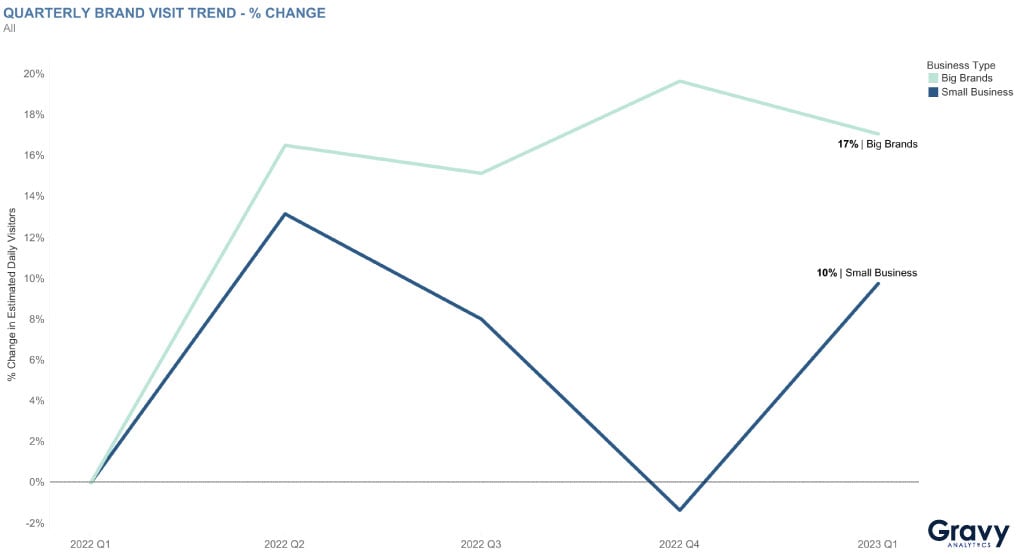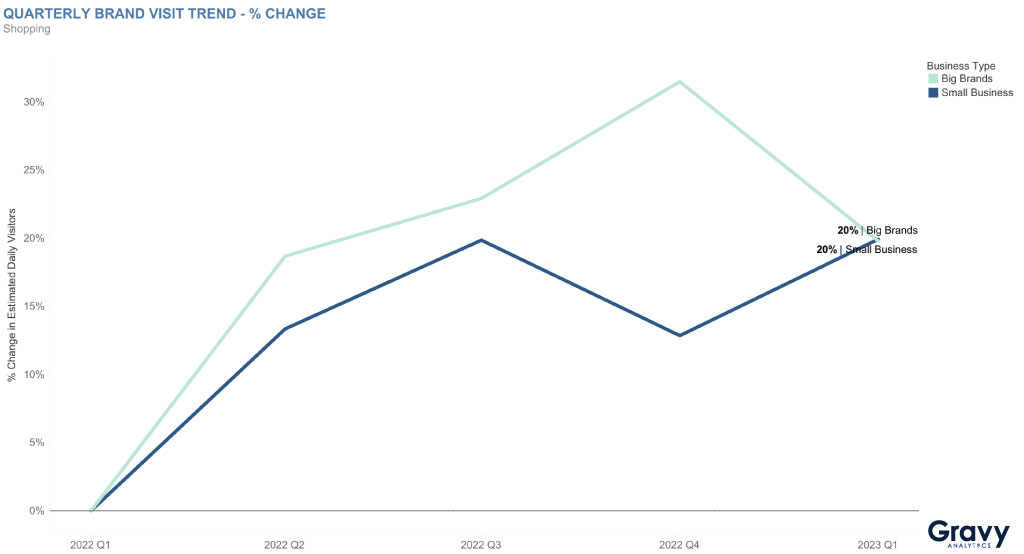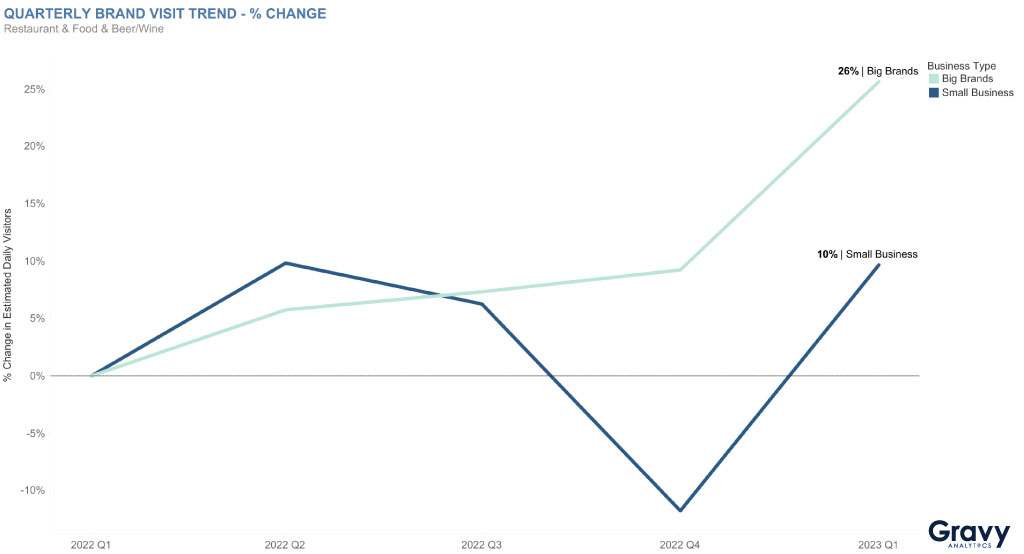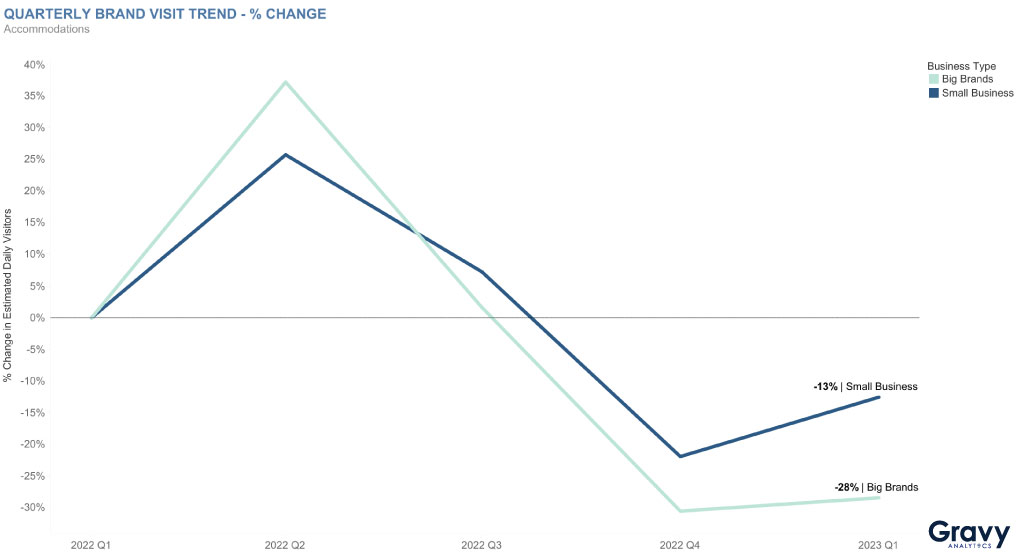What Foot Traffic to Small Businesses Says About Current Consumer Trends
May 9, 2023

Consumer interests and trends are always shifting, and recent foot traffic to small businesses may be an indicator of an emerging trend this year. In 2022, consumer foot traffic favored destinations that were affordable and convenient like fast food restaurants and discount stores. This was likely due to various economic disruptions like rising food costs and gas prices, which led to cost-conscious spending around the country. However, in 2023, recent foot traffic trends are suggesting that consumers are beginning to spend more freely. So, if discretionary spending is becoming more common, will more consumers choose to shop locally or support small businesses over more affordable, major chains?

Foot Traffic to Small Businesses vs. Big Chains

To learn more about what foot traffic looks like to small businesses today, we analyzed small businesses of all categories and compared it with foot traffic to big brands over the last year. From Q1 2022 to Q1 2023, big brands attracted more visitors than small businesses consistently, ending Q1 2023 with a 17% increase in year-over-year foot traffic. With small businesses, foot traffic fluctuated more than it did for the big brands, but they still saw an increase of 10% year-over-year. There was a sizable decrease in foot traffic to small businesses from Q3 to Q4 of 2022, however into Q1 2023, there has been a significant rebound.
Notably, during the first quarter of this year, foot traffic to big chain locations declined slightly from the end of 2022, while foot traffic to small businesses was on a steep rise. Overall, it seems that small businesses are attracting more visitors this year compared to last year, and that could continue as 2023 progresses.
Small businesses are still seeing less foot traffic than big brands overall, but does that trend change if we analyze foot traffic by place category?
Top Performing Categories

Since Q3 2022, in-person shopping has been back in full swing as consumers began to seek simple ways to reconnect socially with each other post-pandemic. Since then, big brands have attracted great growth in foot traffic, particularly discount stores like Walmart. Large chains took precedence as inflation, nationwide layoffs, and other economic concerns arose. However, after Q4 2022, big chain shopping destinations have been steadily losing foot traffic as foot traffic to small businesses has been increasing in this category.
Perhaps discretionary spending is back in action when it comes to shopping, driving consumers back into locally owned businesses that don’t have the means for competitive affordability, but offer unique products and shopping experiences.
As of Q1 2023, both big chains and small businesses saw a 20% increase in foot traffic year-over-year, but small businesses could continue attracting consumers this year if shoppers continue spending more freely.

Small businesses in the auto industry is also seeing an increase in foot traffic, and they’re currently beating out the big brands. Small automotive businesses ended Q1 2023 with a 21% year-over-year increase in foot traffic while big brands saw an increase of 19%. While foot traffic increased significantly across the board in Q2 2022, it quickly declined in Q3 and rose again in Q4. While we’ll probably see another sharp increase in foot traffic to automotive businesses in Q2 this year, it will be interesting to see if smaller businesses continue to take precedence over big brands in the industry. As the automotive industry continues to be shaken by disruptions and sky-high prices, will big brands come out on top later this year?
Consumer Trends & What They Tell Us
While smaller businesses in the shopping and automotive industries attract competitive levels of foot traffic growth compared to big chains, it’s worth noting that foot traffic is growing across the board for the categories we analyzed. For example, in the restaurants and accommodations industries, foot traffic to small businesses has increased significantly in Q1 2023 from the previous quarter.


It seems that after Q4 2022, when most consumers tend to save money for the holidays, foot traffic to small businesses everywhere has been increasing. Small businesses often offer better customer experiences and unique products or services that can’t be found at big chain locations, and 82% of consumers prioritize supporting small businesses when they can. So, perhaps since the pressures of the holiday season have subsided and consumers are back to spending more freely, they’re prioritizing small businesses more.
As 2023 progresses, discretionary spending will likely continue, and because small businesses tend to be pricier than their big chain counterparts, this could be the year that small businesses make a significant comeback in foot traffic growth. On top of that, travel is likely to boom this year as well, providing a boost to local economies as tourists seek out small businesses.
When consumers begin to spend more readily, they tend to prioritize values like customer service, sustainability, and community. Although products at small businesses often come at a higher price point, these businesses connect with their customers through their values and unique offerings that big brands don’t typically offer. This is why foot traffic to small businesses could continue to rise this year, fueling local economies and growth.
For more foot traffic and consumer insights like this, subscribe to our email newsletter today.




